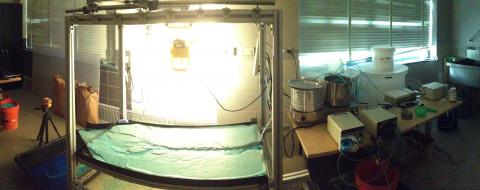CMD is a recirculating flume (dimensions: 120cm long x 60cm wide 10cm deep) that is designed to accelerate chemical reactions and sedimentary processes to study sedimentation over space and time scales that are inaccessible in the field. The CMD flume includes: a reservoir tank to dissolve limestone using CO2 gas and produce artificial spring water; peristaltic pumps to drive water through the system; a heater to control the temperature of the spring water; a feeder to control sediment supply; and a flume where carbonate sediment deposits. The spring water containing dissolved calcium and carbonate ions moves through the heater, into the flume, and then it recirculates back to the reservoir tank. The open surface of the flume by design further enhances carbonate precipitation by allowing CO2 degassing, temperature decrease, and pH increase. Subsequently, this unique system achieves about one millimeter thick carbonate deposit per day. The CMD flume produces high-resolution data, both physical and chemical. Overhead time-lapse photography continuously captures the initiation of self-organizing channel and its evolution. A white-light scanner generates three-dimensional topographic data that records channel geometry and pattern evolution. Chemical conditions, such as temperature, pH, and conductivity, of the spring water in the reservoir tank and out of the flume, are monitored and collected throughout the experiments.
